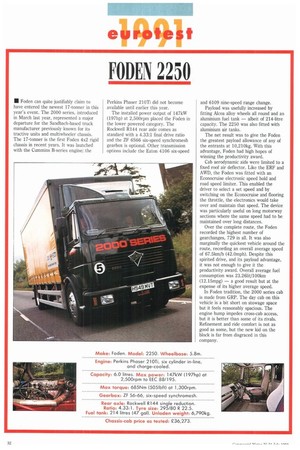FODEN 2250
Page 34

If you've noticed an error in this article please click here to report it so we can fix it.
• Foden can quite justifiably claim to have entered the newest 17-tonner in this year's event. The 2000 series, introduced in March last year, represented a major departure for the Sandbach-based truck manufacturer previously known for its tractive units and multiwheeler chassis. The 17-tonner is the first Foden 4x2 rigid chassis in recent years. It was launched with the Cummins B-series engine; the Perkins Phaser 210Ti did not become available until earlier this year.
The installed power output of 147kW (197hp) at 2,500rpm placed the Foden in the lower powered category. The Rockwell R144 rear axle comes as standard with a 4.33:1 final drive ratio and the ZF 6566 six-speed synchromesh gearbox is optional. Other transmission options include the Eaton 4106 six-speed and 6109 nine-speed range change.
Payload was usefully increased by fitting Alcoa alloy wheels all round and an aluminium fuel tank — albeit of 214-litre capacity. The 2250 was also fitted with aluminium air tanks.
The net result was to give the Foden the greatest payload allowance of any of the entrants at 10,210kg. With this advantage, Foden had high hopes of winning the productivity award.
Cab aerodynamic aids were limited to a fixed roof air deflector. Like the ERF and AWD, the Foden was fitted with an Econocruise electronic speed hold and road speed limiter. This enabled the driver to select a set speed and by switching on the Econocruise and flooring the throttle, the electronics would take over and maintain that speed. The device was particularly useful on long motorway sections where the same speed had to be maintained over long distances.
Over the complete route, the Foden recorded the highest number of gearchanges, 729 in all. It was also marginally the quickest vehicle around the route, recording an overall average speed of 67.51an/h (42.0mph). Despite this spirited drive, and its payload advantage, it was not enough to give it the productivity award. Overall average fuel consumption was 23.261k/100km (12.15mpg) — a good result but at the expense of its higher average speed.
In Foden tradition, the 2000 series cab is made from GRP. The day cab on this vehicle is a bit short on stowage space but it feels reasonably spacious. The engine hump impedes cross-cab access, but it is better than some of its rivals. Refinement and ride comfort is not as good as some, but the new kid on the block is far from disgraced in this company.












































































